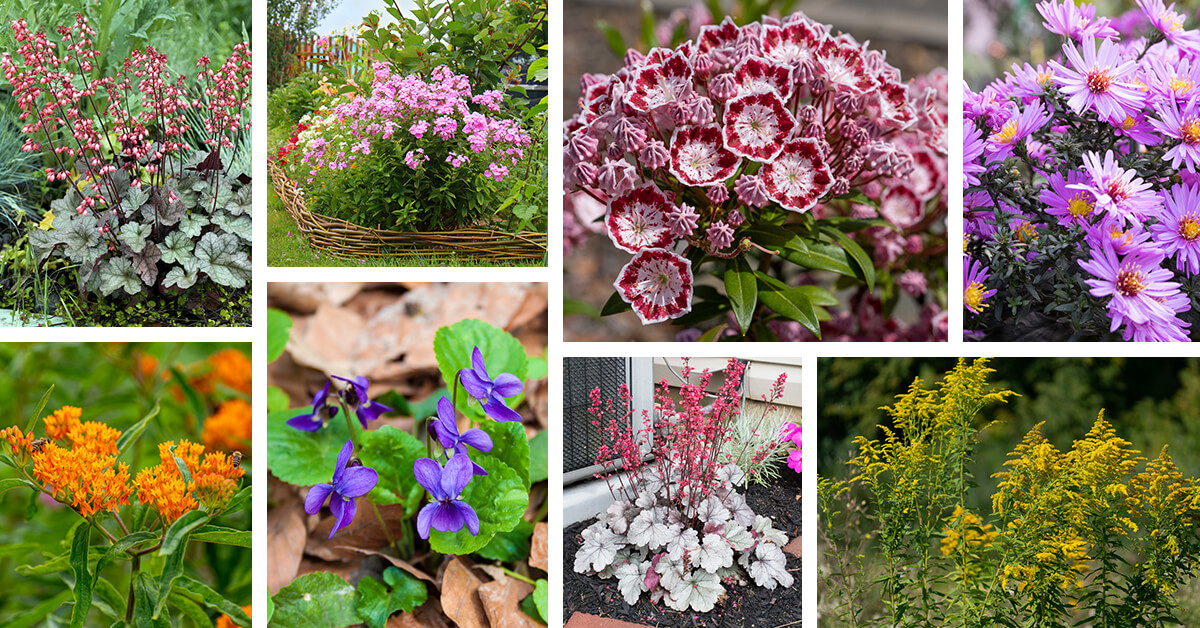Spring is that time of year when the frost finally melts, and all living things start to recover from their long winter nap. The days are getting longer, and the temperature gradually starts going up.
27 Best Spring Flowers to Have in your Garden

Flowers are blooming everywhere, and what better way to celebrate than by adding the best spring flowers to your home. Not only are flowers beautiful to look at, but they will also de-stress your life and provide a welcome, natural way to brighten up your environment.
1. Yellow Trout Lily (Erythronium Americanum)
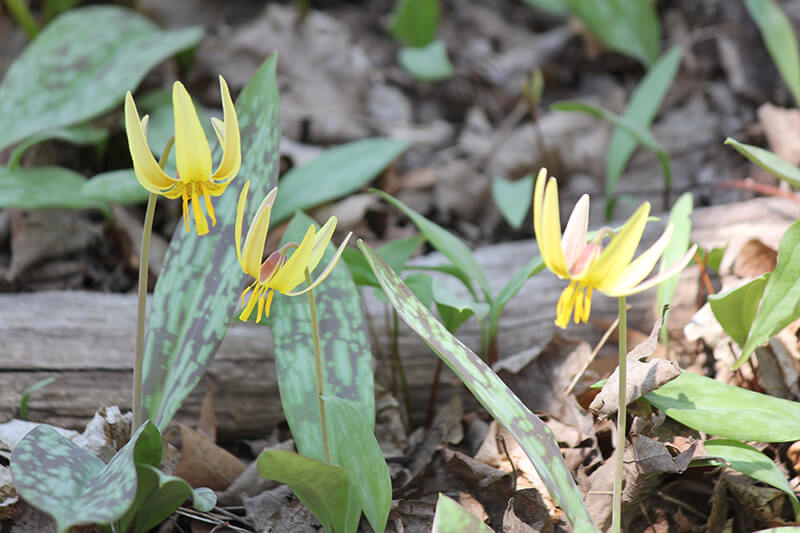
- 🔮 Symbolism: Good luck
- 💧 Water needs: Moist
- 🪴 Soil needs: Fertile, average soil
- 🌍 Growing zones: 3 to 8
- ☀️ Light needs: Full sun to partial shade
- 🌱 Blooming season: April to June
Erythronium americanum is a species of flowering plant native to forests and woodlands. It produces a solitary, nodding, bell-shaped flower. It is most notable for the large petals with a striped or possibly spotted pattern. Erythronium americanum is a great plant for beginner gardeners and experienced gardeners alike. It is easy to grow, quickly propagate, and grown from seeds or cuttings.
One of the best spring yellow flower plants to have in your garden is the trout lily. Yellow trout lily is a perennial flower that can grow year-round in the right environment. This makes it a perfect flower to add to your garden because you’ll be able to enjoy its beauty each season of the year.
2. Harbinger of Spring (Erigenia Bulbosa)
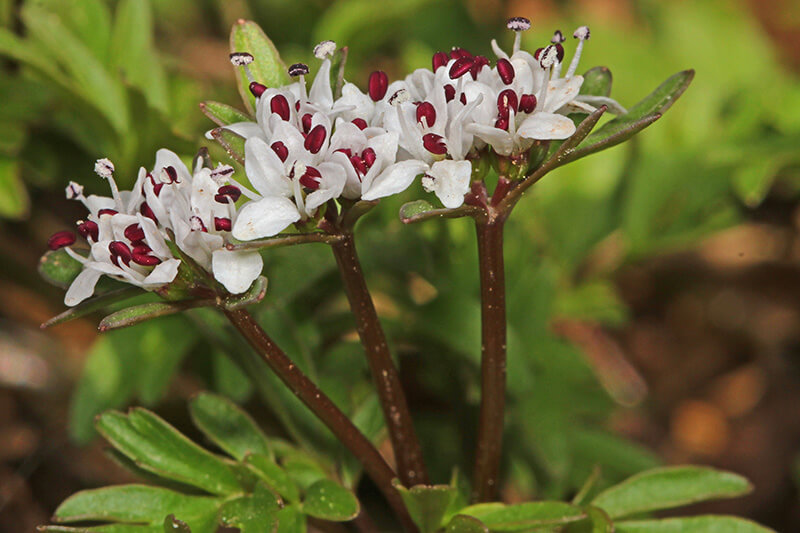
- 🔮 Symbolism: Good fortune and well-being
- 💧 Water needs: Moist
- 🪴 Soil needs: Fertile, average soil
- 🌍 Growing zones: 5 to 7
- ☀️ Light needs: Part shade
- 🌱 Blooming season: March to May
The name Erigenia bulbosa comes from the bulbous nature of their flowers, which makes this plant more decorative. They grow tall in the family and come in all different colors.
Harbinger of Spring is a perfect flower for those new to planting because it has an easy-going personality and is pretty carefree. If you are a beginner, these are the types of spring flowers you can easily grow in your garden or pots on your porch.
3. Heart-Leaf Foam Flower (Tiarella Cordifolia)
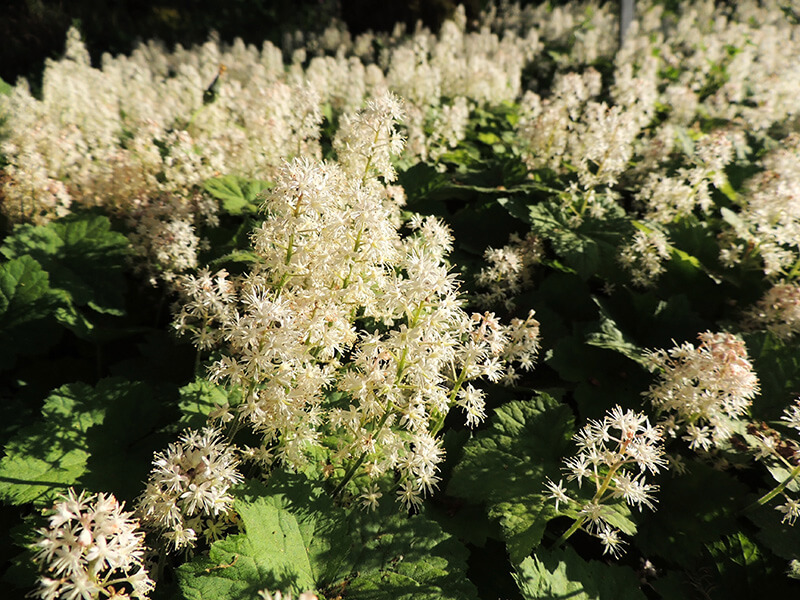
- 🔮 Symbolism: Good luck
- 💧 Water needs: Moist
- 🪴 Soil needs: Fertile soil that is free of pollutants
- 🌍 Growing zones: 3 to 8
- ☀️ Light needs: Partial sun to light shade
- 🌱 Blooming season: May to June
The heart-leaf foam flower’s name comes from the fact that the leaf-like tips of the flower are covered in air bubbles, hence the foam. It is a great option to have in your garden because it won’t take up too much space, but it will brighten up your garden in a beautiful way.
Heart-leaf foam flower is a great plant in your garden because it creates a colorful, vibrant environment. It is an easy plant to grow and grows well in containers to move around easily.
4. Wood Violet (Viola Pedata)
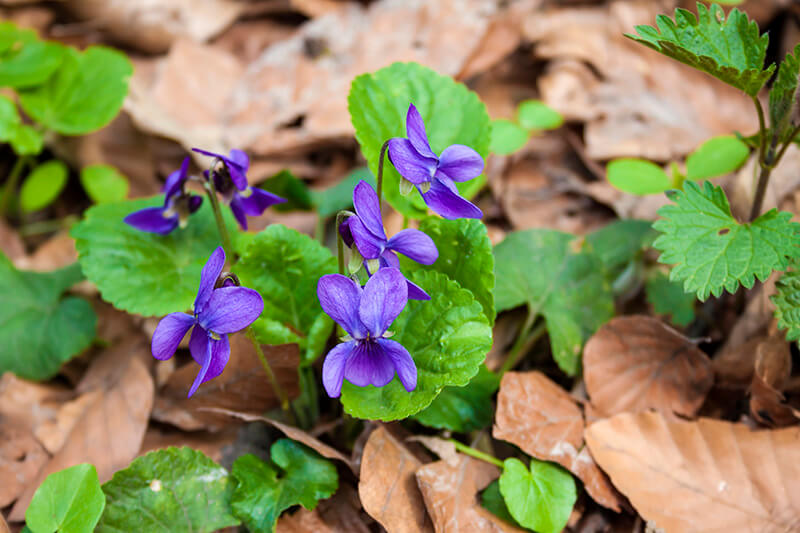
- 🔮 Symbolism: Good fortune, purity, love, and wealth
- 💧 Water needs: Moist
- 🪴 Soil needs: Average soil
- 🌍 Growing zones: 3 to 9
- ☀️ Light needs: Light shade
- 🌱 Blooming season: April to June
The wood violet is a perennial that can grow up to six feet tall. It comes in a variety of shapes, colors, and sizes. The flowers are fragrant and grow in clusters. Some varieties have dark purple flower petals, while others have light blue petals.
Wood violet is one of the most beautiful types of spring flowers. They are the perfect inspiration for gardeners to use when designing their fresh and vibrant landscapes.
5. Spring Beauty (Claytonia Virginica)
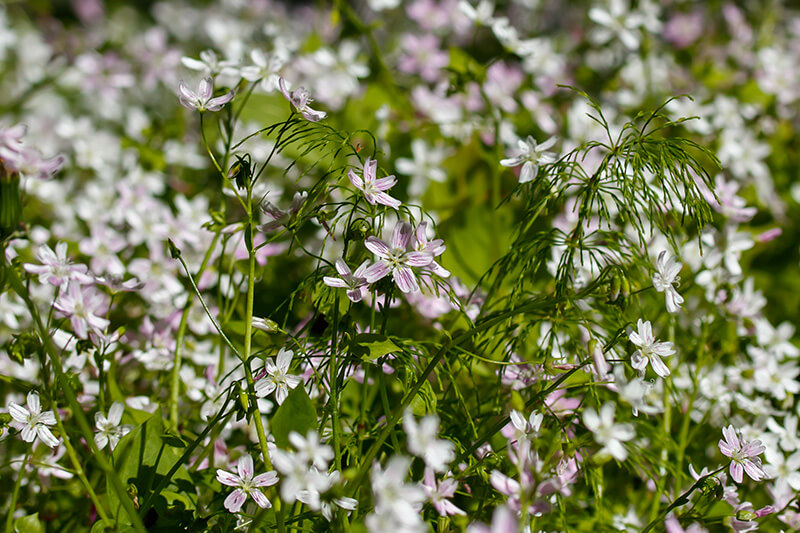
- 🔮 Symbolism: Good luck, health, and love
- 💧 Water needs: Average
- 🪴 Soil needs: Fertile, average soil
- 🌍 Growing zones: 4 to 9
- ☀️ Light needs: Dappled sunlight and partial shade
- 🌱 Blooming season: February to May
Claytonia virginica is a brightly colored herbaceous wildflower. The flowers are very fragrant. They are a great plant for gardeners because they are easy to grow and sturdy. Claytonia virginica is a spring flower that grows in many lovely places in the wild.
It is a self-sufficient flower, and it’s effortless to take care of. Bees, butterflies, and birds also appreciate this flower. With these beautiful features, spring beauty is sure to be a favorite amongst gardeners.
6. Alumroot (Heuchera Americana)
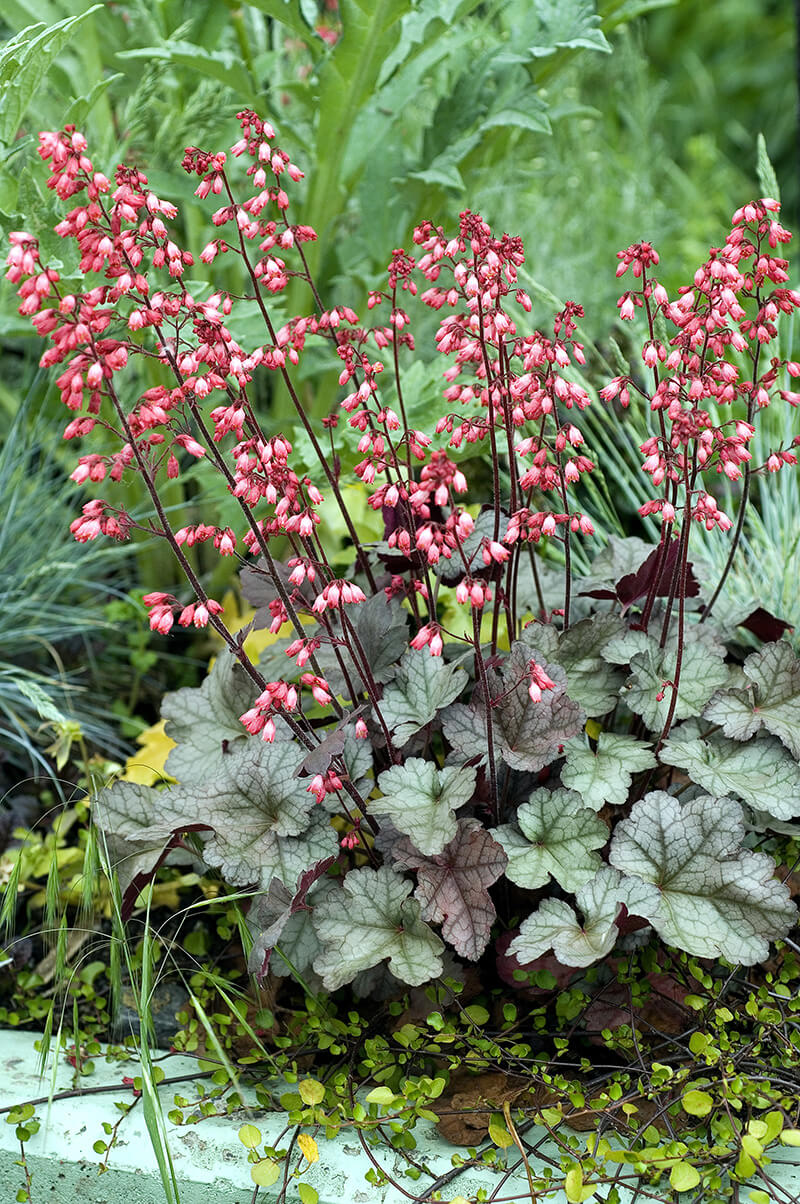
- 🔮 Symbolism: Grief
- 💧 Water needs: Moist
- 🪴 Soil needs: Average soil
- 🌍 Growing zones: 4 to 9
- ☀️ Light needs: Partial shade
- 🌱 Blooming season: March to May
The plant has a long history of use in traditional medicine, and it was also used for the dyeing of blankets and textiles. Alumroot is one of the most beautiful types of spring flowers. It is a low-growing evergreen with the ability to grow in many environments. This means that it is an excellent plant to add to your garden.
Alumroot is a cool spring flower that stands out in the gardening world. If you are looking for a different kind of flower in your garden, you can’t go wrong with alumroot. This spring flower plant attracts birds as well as butterflies.
7. Redbud (Cercis Canadensis)
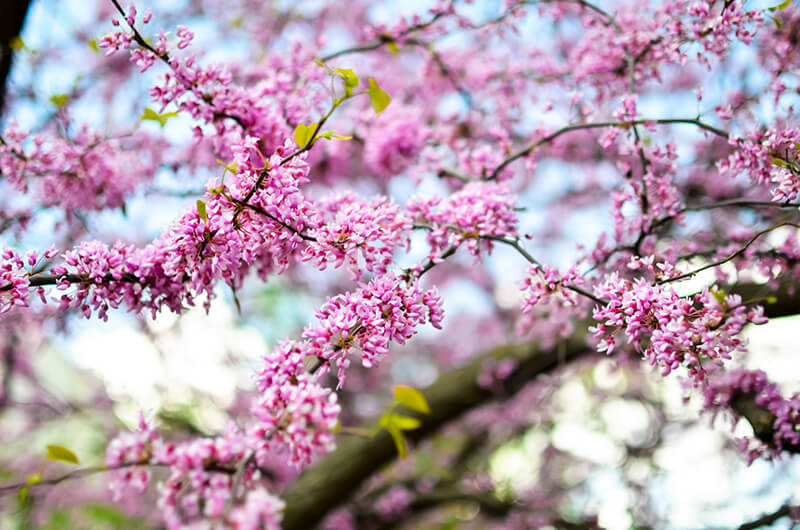
- 🔮 Symbolism: Hope
- 💧 Water needs: Moist
- 🪴 Soil needs: Fertile, average soil
- 🌍 Growing zones: 4 to 9
- ☀️ Light needs: Full sun to part shade
- 🌱 Blooming season: March to May
The redbud is a tree that belongs to the genus Cercis, and it has been used for its medicinal properties. When it comes to the spring, the redbud grows in clusters at the top of its branches. It is a vibrant tree that people can enjoy seeing in their midst.
Redbud is also known as flowering dogwood because of the shape of its red blossoms. This type of spring flower can be found in forests, meadows, and fields. This plant is remarkably resilient.
8. Butterfly Weed (Asclepias Tuberosa)
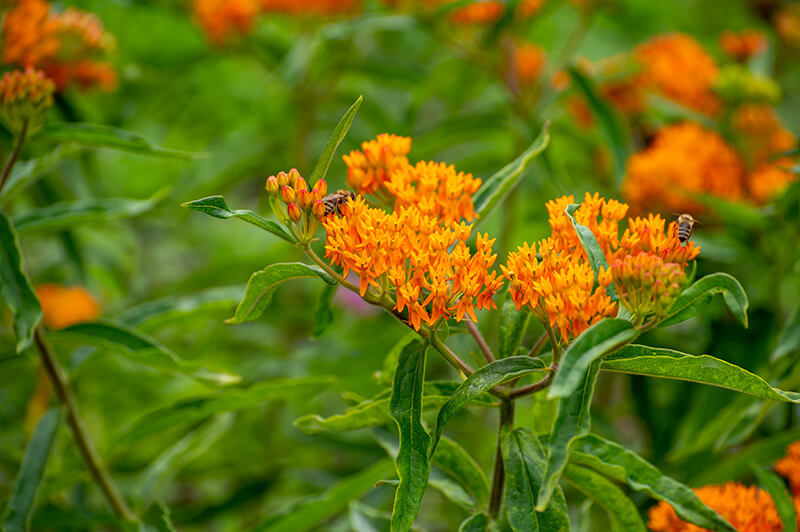
- 🔮 Symbolism: Remembrance, dignity and freedom
- 💧 Water needs: Moist
- 🪴 Soil needs: Rich soil
- 🌍 Growing zones: 3 to 9
- ☀️ Light needs: Bright sunlight
- 🌱 Blooming season: April to May
The flower’s name comes from the blooms being most attractive to butterflies. This variety is grown in ornamental gardens. This plant blooms in clusters with flowers that grow upward. Not only does it attract butterflies, but also bees.
Butterfly Weed is an exotic-looking spring flower that grows in clusters at the top of its stalks. This flower attracts butterflies because of the fragrance coming from its stems. It is a fantastic addition to your garden because it has small blooms that can be easily overlooked.
9. Bloodroot (Sanguinaria Canadensis)
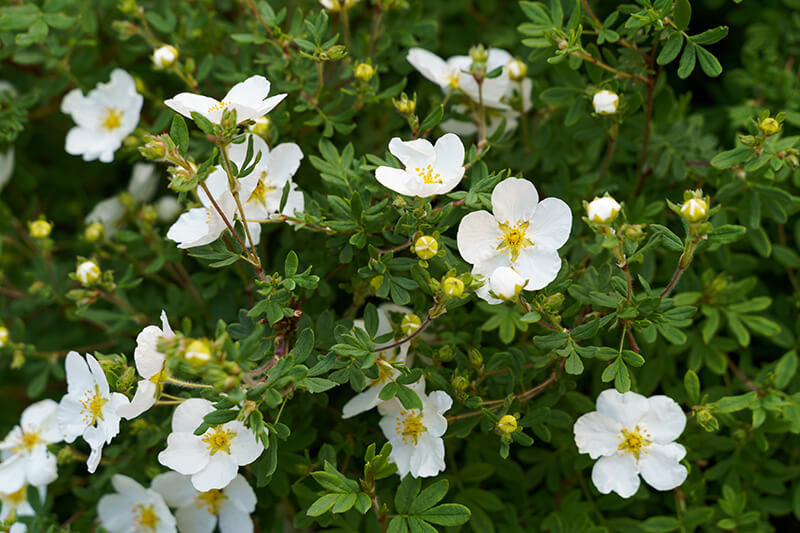
- 🔮 Symbolism: Change of Seasons
- 💧 Water needs: Moist
- 🪴 Soil needs: Fertile, average soil
- 🌍 Growing zones: 3 to 8
- ☀️ Light needs: Part shade to full shade
- 🌱 Blooming season: April to May
Bloodroot was originally used for medicinal properties, but now it is grown for ornamental gardens. It is a perennial used in the past as a dye. It is an easy-to-grow flower, and it is also said to be an endangered species.
Bloodroot is a unique type of spring flower. This plant attracts butterflies, bees, and hummingbirds. Bloodroot contains a sap that is used as a dye for clothing. This spring flower plant is also used to help people with respiratory problems. It is a small, delicate, vibrant flower that can be easily in your garden.
10. Wild Geranium (Geranium Macrorrhizum)
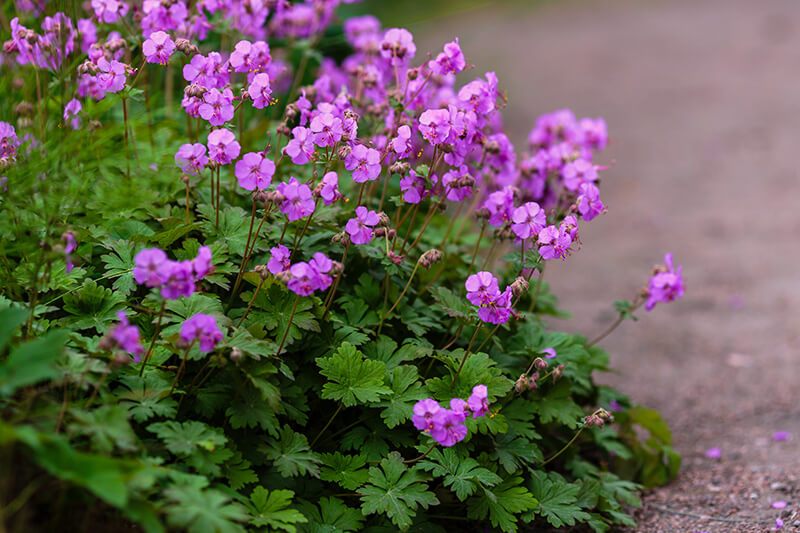
- 🔮 Symbolism: Peace and unity
- 💧 Water needs: Average
- 🪴 Soil needs: Fertile, average soil
- 🌍 Growing zones: 3 to 8
- ☀️ Light needs: Full sun
- 🌱 Blooming season: March to May
The Native Americans called this flower the “lotus of the woods” and mainly used it for medicinal purposes. It is a cold-hardy plant that can grow in many other environments. This means that you can use it to make your garden more attractive.
This plant is an attractive addition to your garden because it has a unique bloom that is soft and easy to touch. It has deep roots, which makes it solid and well-established.
11. Rattlesnake Master (Eryngium Yuccifolium)
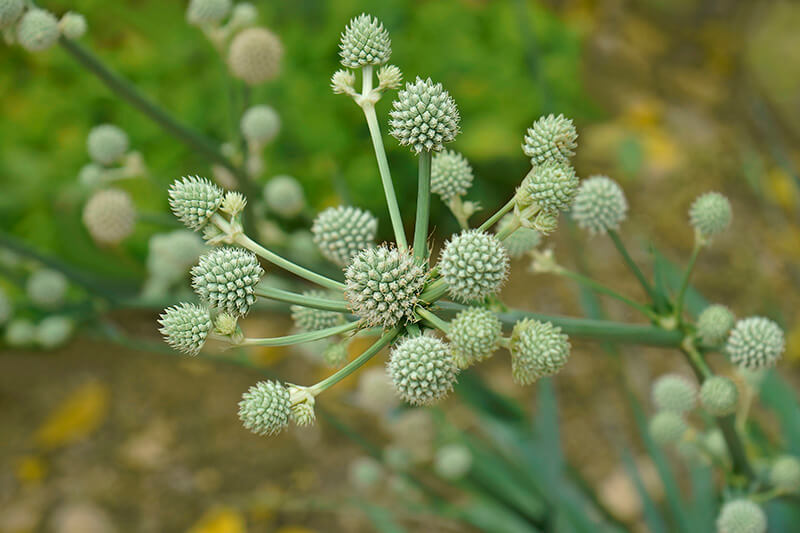
- 🔮 Symbolism: Protection
- 💧 Water needs: Average
- 🪴 Soil needs: Average soil
- 🌍 Growing zones: 4 to 9
- ☀️ Light needs: Full sun
- 🌱 Blooming season: May to September
This plant is named after its distinctive flower that looks like a snake’s head. The flower has a long history of use in the traditional medicine of American Indians. This flower is a biennial plant that thrives in the wild.
This plant has long leaves that are soft and flexible. The flowers have a deep scent that attracts moths, butterflies, and many other animals.
12. Lady’s Tresses (Spiranthes Cernua)
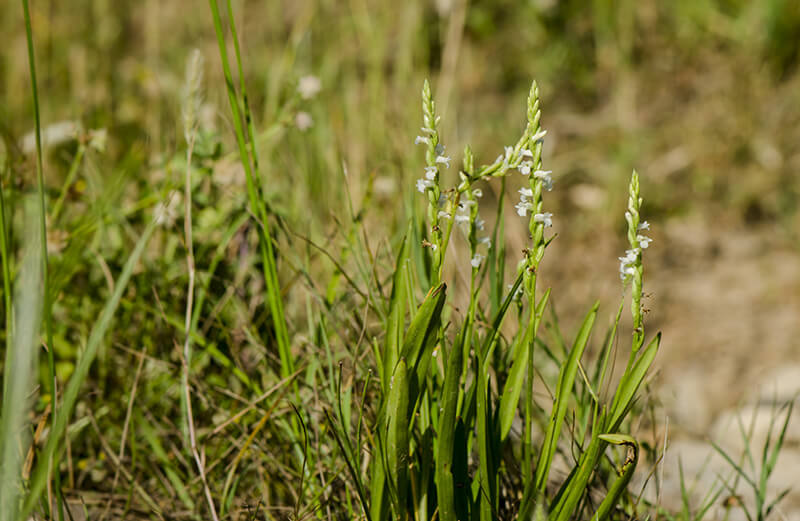
- 🔮 Symbolism: Strength, protection, and good luck
- 💧 Water needs: Moist
- 🪴 Soil needs: Average soil
- 🌍 Growing zones: 5 to 9
- ☀️ Light needs: Partial to full sun
- 🌱 Blooming season: May to September
Lady’s tresses is a perennial that comes from the orchid family. It is a delicate type of spring flower, and it has been used in traditional medicine. This flower attracts birds, butterflies, and bees. This allows you to enjoy this plant’s beauty in your garden.
Lady’s tresses is an exotic and beautiful orchid that has long soft leaves that preachers and ministers popularly use because they are solid and well-established. It was valued more than gold by people in the 16th century.
13. New England Aster
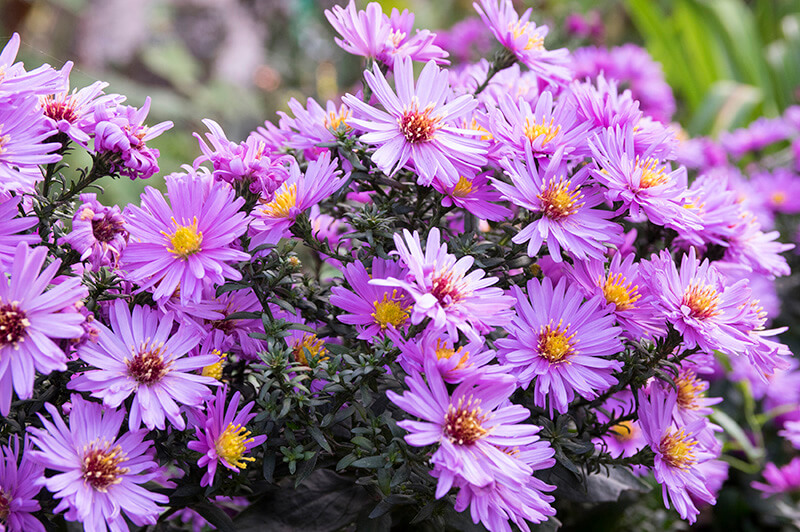
- 🔮 Symbolism: Wealth
- 💧 Water needs: Average
- 🪴 Soil needs: Fertile, average soil
- 🌍 Growing zones: 4 to 8
- ☀️ Light needs: Full sun
- 🌱 Blooming season: May to July
This flower is used for ornamental purposes, and it is also essential for the wildlife of the areas in which it grows. It is also known as the “Jacob’s ladder” because of its unusual growth habit. Many people use this plant for medicinal properties.
New England Aster is an amazing spring flower that can attract birds and bees because it blooms from May until July. Its small leaves are soft and flexible. The flowers of this plant have a unique scent that attracts moths, butterflies, and bees. New England Aster is an attractive addition to any garden or yard because of its delicate flower.
14. Meadow Rue (Thalictrum Dasycarpum)
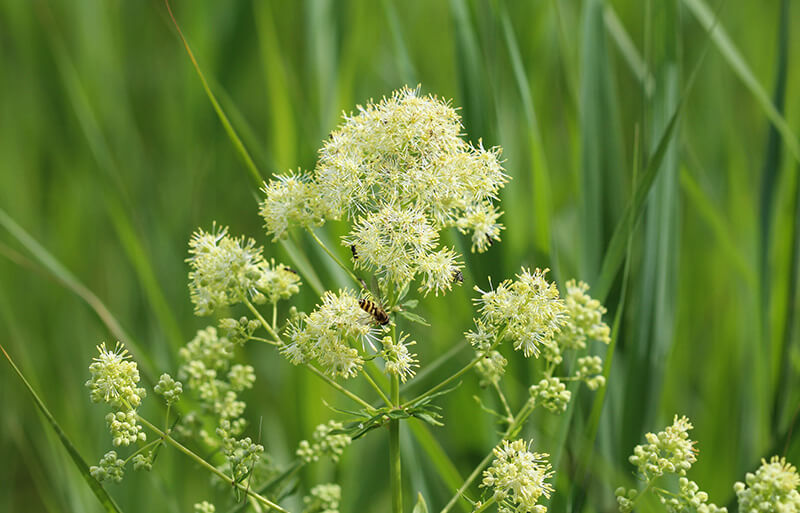
- 🔮 Symbolism: Wishes
- 💧 Water needs: Average
- 🪴 Soil needs: Average soil
- 🌍 Growing zones: 3 to 9
- ☀️ Light needs: Dappled light conditions
- 🌱 Blooming season: April to May
This perennial flower has been used in the past as a medicine. It’s a dreaded plant because of its odd flowers, and it is also poisonous to some insects. The leaves and stems are part of the poisonous plant family.
This flower has a glossy texture, and its leaves are sensitive to cold temperatures. Meadows Rue is easy to grow, but you should handle this plant with care. You can use it in wild areas to control overgrowth.
15. Garden Phlox (Phlox paniculata)
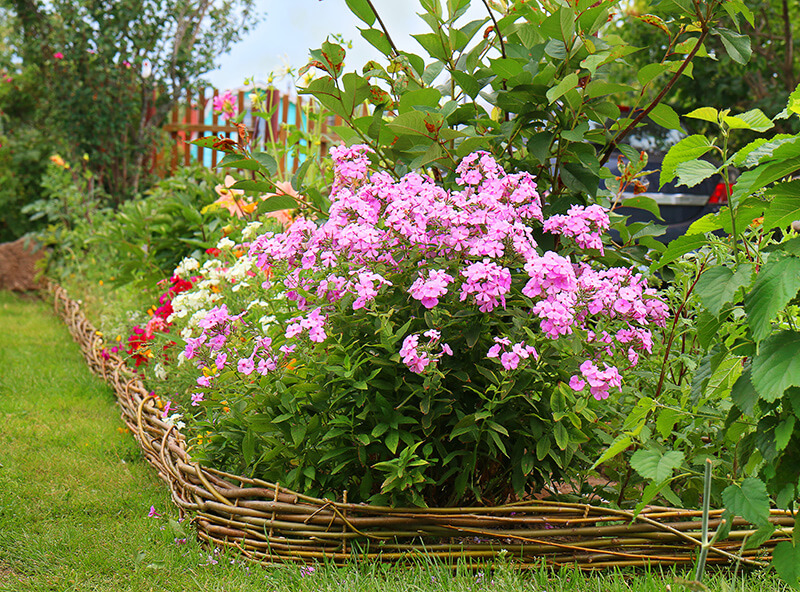
- 🔮 Symbolism: Peace
- 💧 Water needs: Moist
- 🪴 Soil needs: Average soil
- 🌍 Growing zones: 4 to 8
- ☀️ Light needs: Full sun
- 🌱 Blooming season: March to May
It has been used in traditional medicine to heal a variety of conditions. It is also popularly used in ornamental flower gardens because it attracts a lot of insects and birds.
This is a perennial that is easy to grow and has attractive flowers. Its common name, “garden phlox,” comes from its attractive flower attracting bees and butterflies. Garden phlox grows in most areas found naturally with other plants.
16. Meadow Saffron (Rhodiola Rosea)
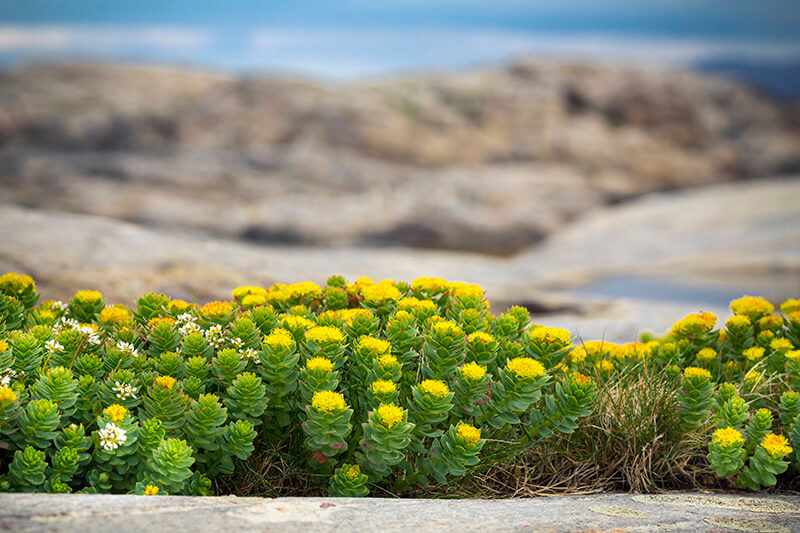
- 🔮 Symbolism: Healing and strength
- 💧 Water needs: Moist
- 🪴 Soil needs: Average soil
- 🌍 Growing zones: 4 to 9
- ☀️ Light needs: Full sun to part shade
- 🌱 Blooming season: April to May
Saffron is an unusual plant that has many uses throughout the world. It has been used as a medicine and for food. It is also a plant that has been used to make dye. The flowers have a very distinctive color and can be used in places where they will attract birds.
The plant is a perennial and usually has a solid stem and dark green leaves. Seeds are sometimes found in the flowers that fly away during the season.
17. Striped Maple (Acer Pensylvanicum)
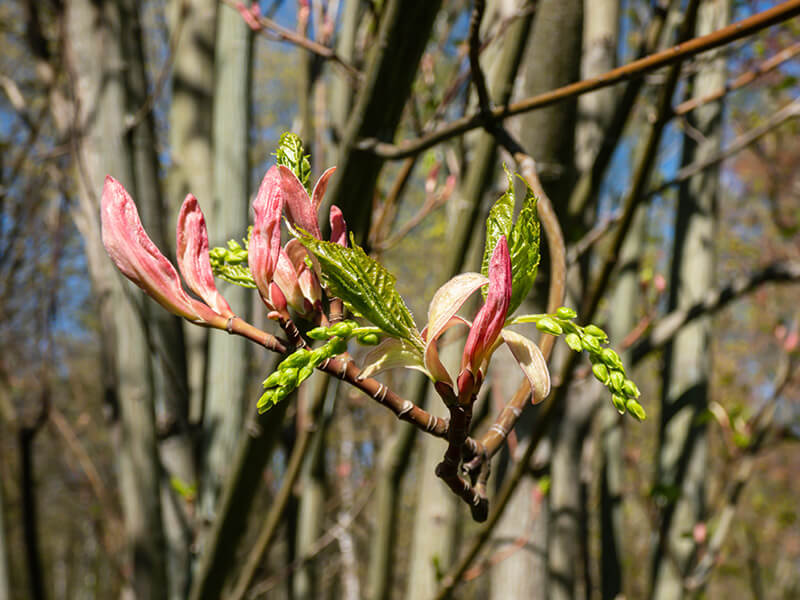
- 🔮 Symbolism: Wisdom
- 💧 Water needs: Moist
- 🪴 Soil needs: Average soil
- 🌍 Growing zones: 3 to 6
- ☀️ Light needs: Full shade
- 🌱 Blooming season: April to May
The maple tree is important as it is a staple in the North American forest. This tree prefers damp areas and humidity, making it endemic to the region. This is an important plant to the local people because it is a food, medicine, and shelter. There are different kinds of maples that produce beans and syrup.
This tree has a very distinct look, and its leaves can grow up to twenty centimeters long. The flowers of this tree are white at first and turn purple near the end.
18. Bitter Sweet (Celastrus scandens)
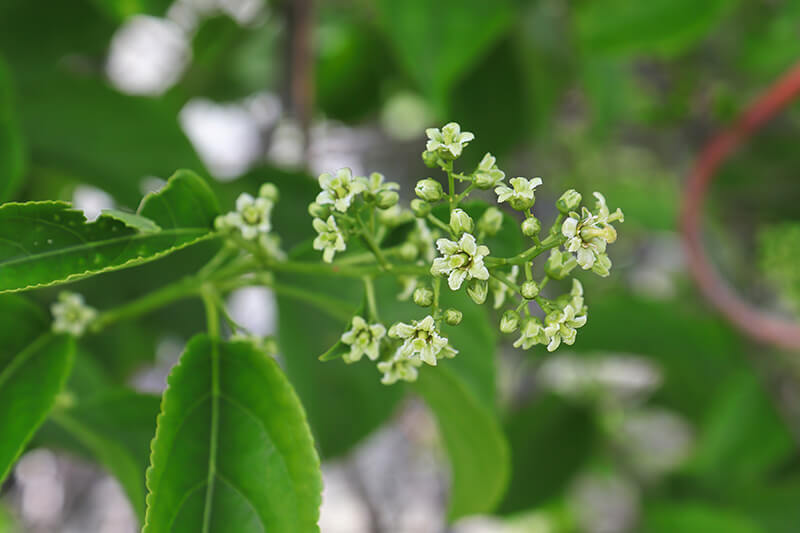
- 🔮 Symbolism: Emotion
- 💧 Water needs: Moist
- 🪴 Soil needs: Average soil
- 🌍 Growing zones: 5 to 8
- ☀️ Light needs: Full sun to partial shade
- 🌱 Blooming season: April to May
Celastrus is an important plant because the seeds can be made into tea to soothe headaches and irritations. The seeds can also be ground and mixed with flour to make bread. The flower is also used in a kind of spice. The flowers are used to treat symptoms of asthma and chest ailments.
Celastrus scandens can be used to attract bees and butterflies. This flowering shrub is easy to grow and has attractive flowers. You can grow this plant as a flowering vine or a bush. This plant is mainly known for aesthetic purposes such as landscaping and gardens.
19. Starflower (Cardamine concatenate)
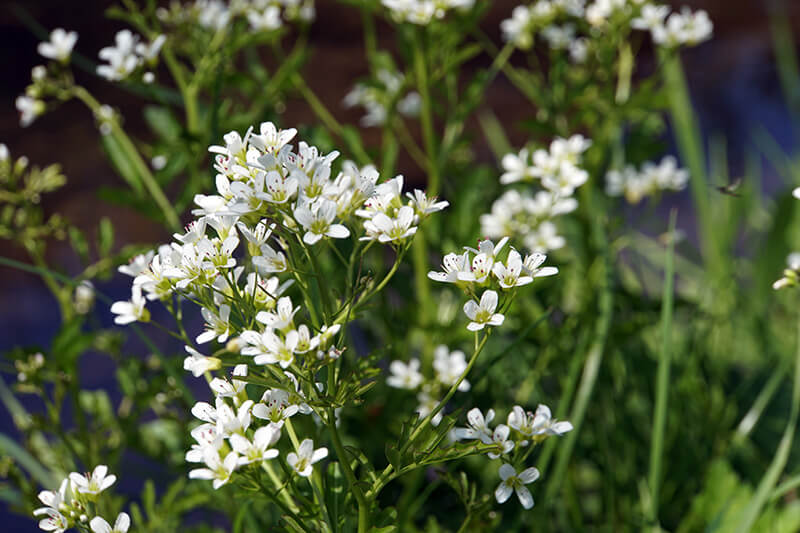
- 🔮 Symbolism: Healing
- 💧 Water needs: Moist
- 🪴 Soil needs: Average soil
- 🌍 Growing zones: 3 to 7
- ☀️ Light needs: Full sun
- 🌱 Blooming season: April to May
The plant is usually referred to as a “field salad,” but it’s not edible, and most would recognize it for its pleasant odor. The flower has a natural color that is used in flower arrangements. The plant is a perennial, and it is used to make tea and insect repellent. The plant was used as a dye in ancient times.
The plant is an integral part of most ecosystems it is found near because it attracts insects and birds, which keeps the local vegetation healthy by controlling pests. Since the plant is a perennial, it is reused, and cold temperatures don’t damage it.
20. Mountain Laurel (Kalmia latifolia)
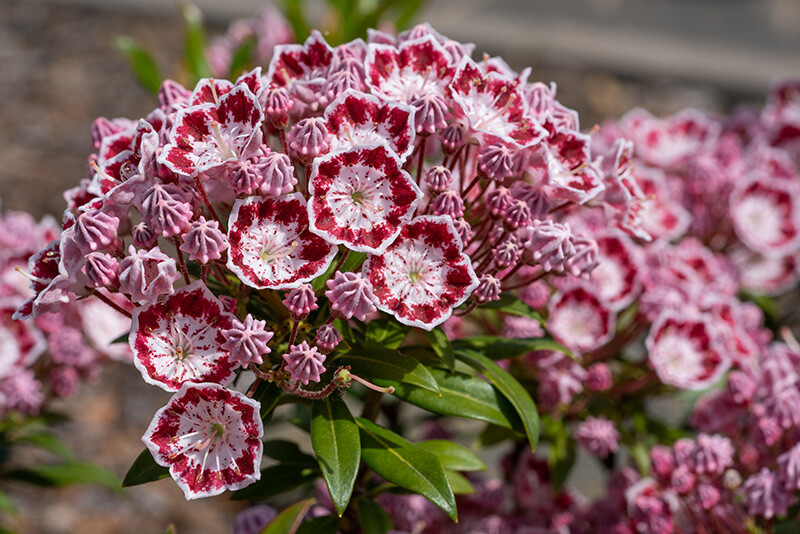
- 🔮 Symbolism: Protection
- 💧 Water needs: Moist
- 🪴 Soil needs: Average soil
- 🌍 Growing zones: 5 to 9
- ☀️ Light needs: Moderate to partial shade
- 🌱 Blooming season: March to May
The name “mountain laurel” comes from the plant that naturally grows in forests higher. This plant has been used as an ornamental flower, food source, and medicine. It’s in the heath family and has evergreen leaves.
This plant has an unusual trunk shaped like a cone when viewed from above. For this reason, it is named the “cone-bush.” The leaves and branches have a somewhat hairy texture, making them soft to the touch around the world.
21. Painted Trillium (Trillium Undulatum)
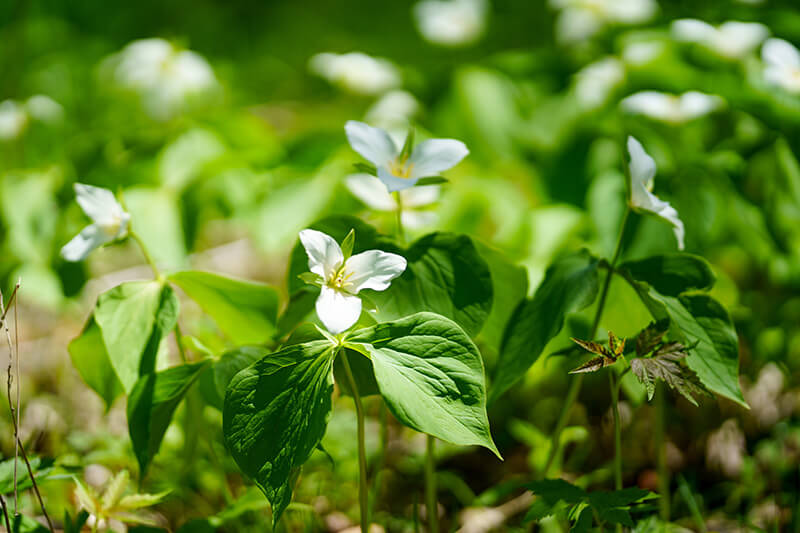
- 🔮 Symbolism: Love
- 💧 Water needs: Moist
- 🪴 Soil needs: Average soil
- 🌍 Growing zones: 3 to 7
- ☀️ Light needs: Part shade or full shade
- 🌱 Blooming season: April to May
The name of this plant comes from the fact that it is often used in making designs on pottery. This plant was used in the past times as a medicine. It is a perennial that produces flowers in a variety of colors.
Painted Trillium is an annual plant that will bloom and then die each year. This plant has been used as a staple in the ecosystem. The plant is colorful, edible, and very sought after by some people because of its shape. This plant has been used as jewelry in different ways.
22. Spiderwort (Tradescantia ohiensis)
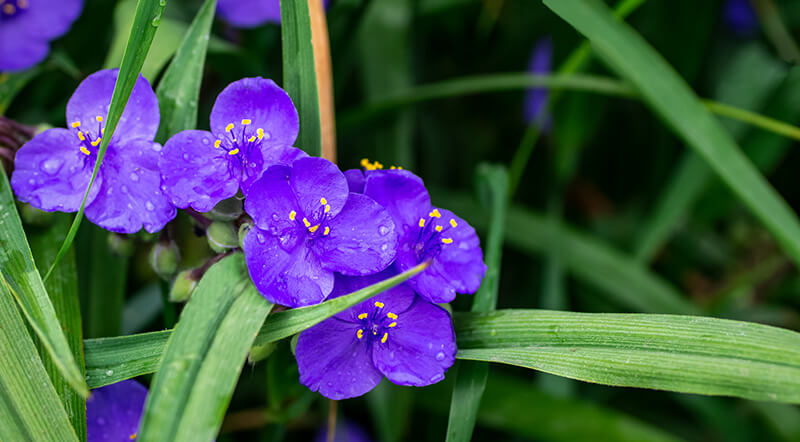
- 🔮 Symbolism: Protection
- 💧 Water needs: Moist
- 🪴 Soil needs: Average soil
- 🌍 Growing zones: 4 to 9
- ☀️ Light needs: Part shade
- 🌱 Blooming season: March to May
This plant has a unique look and has a fuzzy, hairy appearance. The leaves of this plant have tiny oil glands and can be used for tanning animal skins. This plant has also been used to kill insects in the garden but can harm your plants as well.
The plant is used in many different ways. It has been used as an ornamental flower, medicine, and food. With so much attention on the plant, it is imperative in the ecosystem as it helps with nitrogen fixation.
23. Swamp Aster (Symphyotrichum Puniceum)
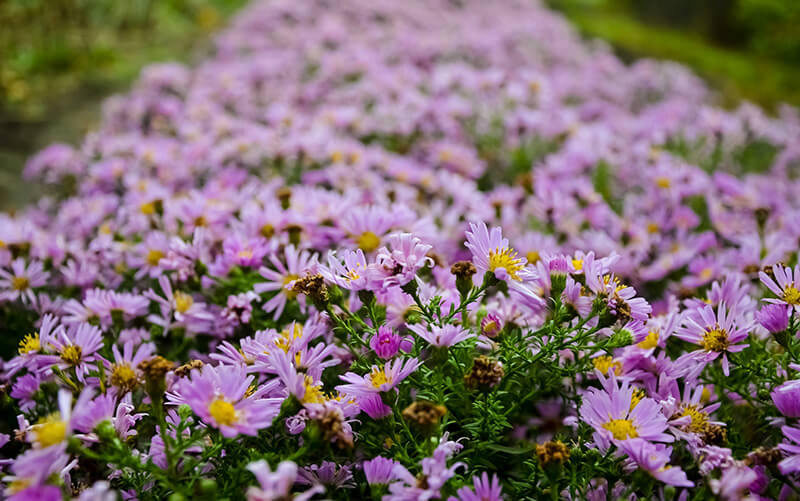
- 🔮 Symbolism: Protection
- 💧 Water needs: Dry
- 🪴 Soil needs: Average soil
- 🌍 Growing zones: 2 to 8
- ☀️ Light needs: Full sun
- 🌱 Blooming season: March to May
This plant is edible and used as medicine in the past. This plant has tiny flowers that turn into fruits. This is an important part of the ecosystem because it provides shelter for various animals.
The swamp aster is an integral part of the ecosystem. It is often used as a way to keep other plants cool. This plant attracts bees, pollinators, and birds. It keeps the ecosystem healthy by controlling pest animals.
24. Prairie Star (Symphyotrichum novae-angliae)
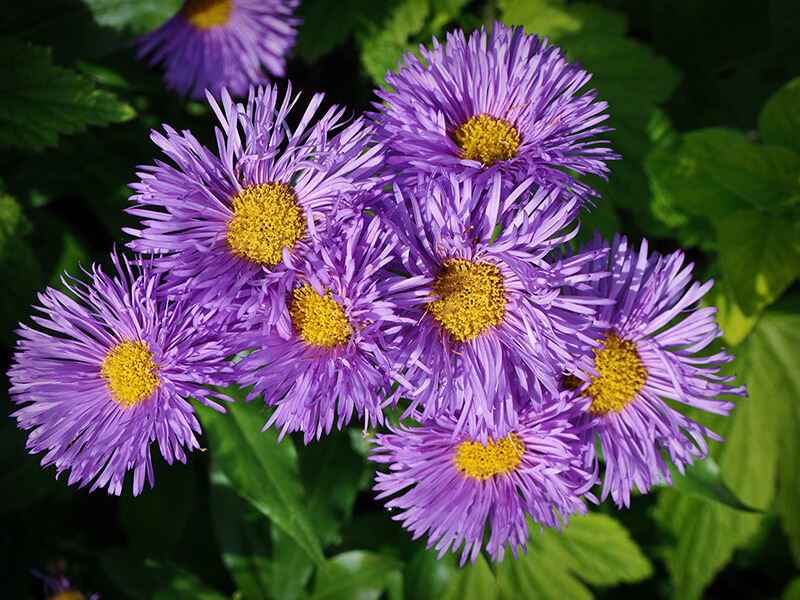
- 🔮 Symbolism: Hope
- 💧 Water needs: Average
- 🪴 Soil needs: Fertile soil
- 🌍 Growing zones: 3 to 9
- ☀️ Light needs: Full sun
- 🌱 Blooming season: April to May
This is a perennial plant found in open areas and native grasslands. It likes to be around other plants, and it can grow to up to two feet tall. The flowers have a distinctive shape, with two lower petals fused.
The plant is best used in gardens because it attracts various insects, birds, and bees. The flowers can also make tea, juice, and jam.
25. Coral Bells (Heuchera Americana)
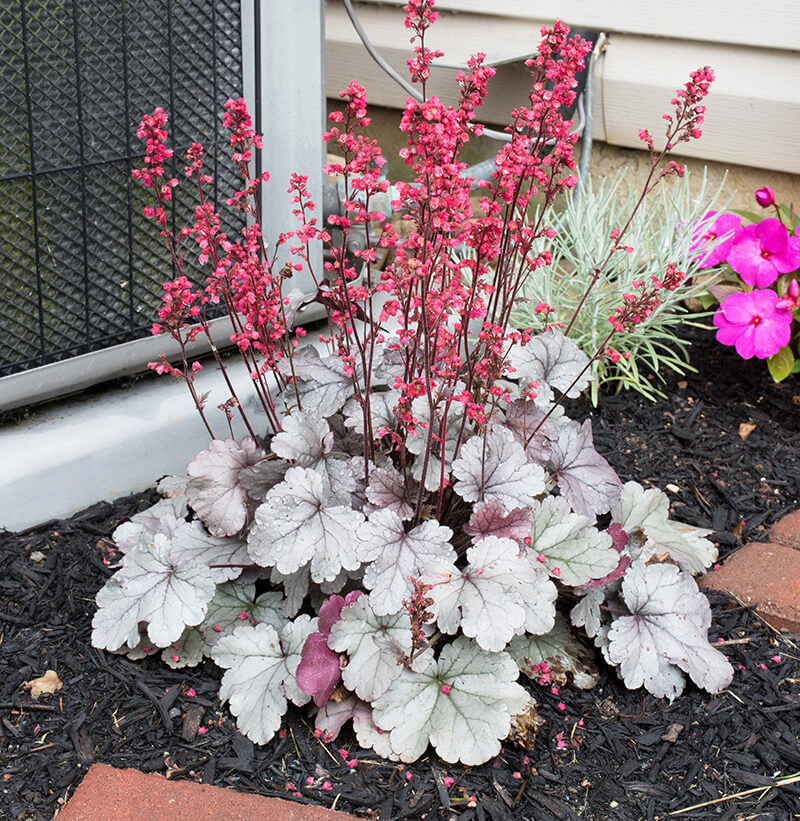
- 🔮 Symbolism: Purity
- 💧 Water needs: Moist
- 🪴 Soil needs: Fertile, average soil
- 🌍 Growing zones: 4 to 9
- ☀️ Light needs: Full sun
- 🌱 Blooming season: April to May
This plant is an essential source of food and medicine for the local people. The flowers are used to make a pink dye, and it has also been used in cosmetics and perfumes. You can use this plant to attract birds and butterflies to your garden or place of interest.
The flower of this plant is often used in southern cuisine, and its roots are used to make tea. This plant is easy to grow and can be used as ornamental.
26. Canada Goldenrod (Solidago Canadensis)
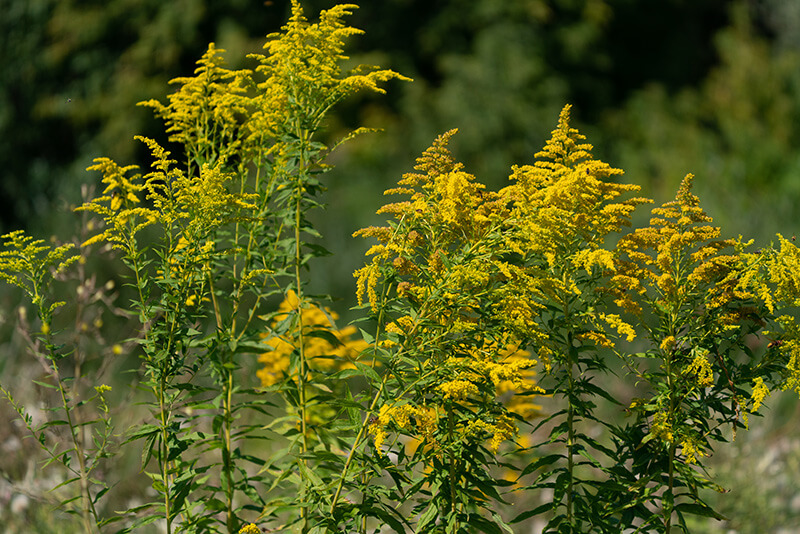
- 🔮 Symbolism: Happiness
- 💧 Water needs: Average
- 🪴 Soil needs: Fertile, average soil
- 🌍 Growing zones: 3 to 9
- ☀️ Light needs: Full sun to part shade
- 🌱 Blooming season: August to October
Canada goldenrod is an essential part of North American plant life. This plant is beneficial since it has many health benefits. It is used to treat cancer, nausea, anxiety, and other ailments.
Canada goldenrod is a tall flower that looks similar to the sunflower. This plant is beautiful to bees and butterflies when it starts blooming in the summer.
27. Wild Bleeding Heart (Dicentra Eximia)
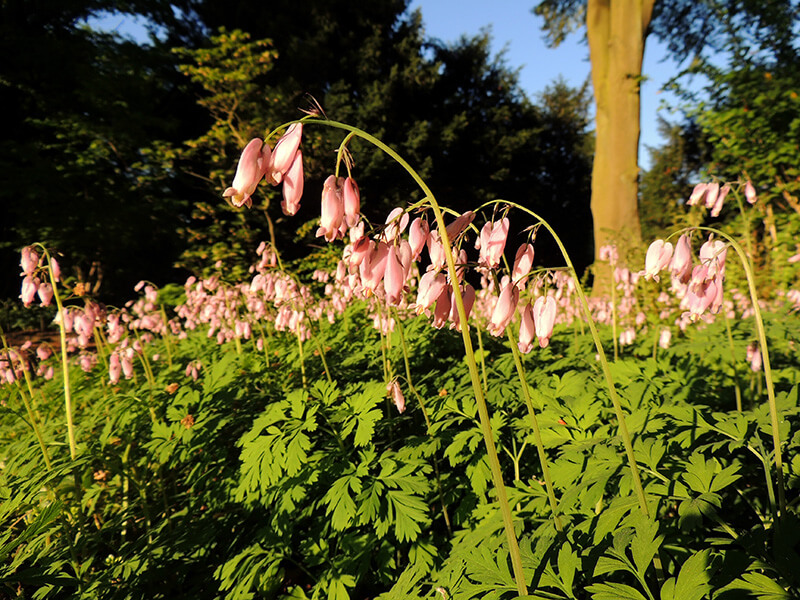
- 🔮 Symbolism: Knowledge
- 💧 Water needs: Average
- 🪴 Soil needs: Fertile, average soil
- 🌍 Growing zones: 3 to 9
- ☀️ Light needs: Part shade
- 🌱 Blooming season: March to June
They have heart-shaped leaves and tall spikes that resemble the flowers of the bleeding heart. The flowers were used by Native Americans to make dye and to treat burns, sores, stings, and bites. Today it is used for its distinctive appearance in bouquets and treating toothaches.
Wild Bleeding Heart is one of the many wildflowers helpful to gardeners. Wild Bleeding Heart is also called a woodland indicator because it grows and flourishes.
27 Best Spring Flowers to Spice Up Your Garden
By now, you should be familiar with the plants that are endemic to your area. You should also understand their safety and cultural value to ensure that you are not consuming a potentially dangerous plant.

